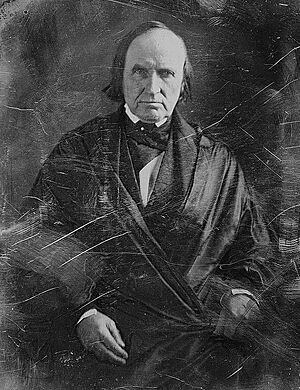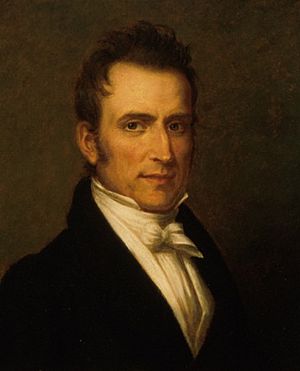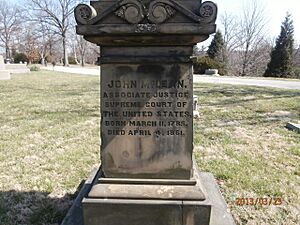John McLean facts for kids
Quick facts for kids
John McLean
|
|
|---|---|

|
|
| Associate Justice of the Supreme Court of the United States | |
| In office March 12, 1829 – April 4, 1861 |
|
| Nominated by | Andrew Jackson |
| Preceded by | Robert Trimble |
| Succeeded by | Noah Swayne |
| United States Postmaster General | |
| In office June 26, 1823 – March 4, 1829 |
|
| President | James Monroe John Quincy Adams |
| Preceded by | Return Meigs |
| Succeeded by | William Barry |
| Commissioner of the General Land Office | |
| In office September 11, 1822 – June 26, 1823 |
|
| President | James Monroe |
| Preceded by | Josiah Meigs |
| Succeeded by | George Graham |
| Associate Justice of the Ohio Supreme Court | |
| In office February 17, 1816 – September 11, 1822 |
|
| Preceded by | William Irvin |
| Succeeded by | Charles Sherman |
| Member of the U.S. House of Representatives from Ohio's 1st district |
|
| In office March 4, 1813 – October 8, 1816 |
|
| Preceded by | Jeremiah Morrow |
| Succeeded by | William Henry Harrison |
| Personal details | |
| Born | March 11, 1785 Morris County, New Jersey, U.S. |
| Died | April 4, 1861 (aged 76) Cincinnati, Ohio, U.S. |
| Political party | Democratic-Republican (before 1825) National Republican (1825–1828) Democratic (1828–1831) Anti-Masonic (1831–1838) Whig (1838–1848) Free Soil (1848–1854) Republican (1854–1861) |
| Other political affiliations |
Jacksonian |
| Spouses |
Rebecca Edwards
(m. 1807; died 1841)Sarah Ludlow
(m. 1843) |
| Children | 6 |
| Education | Harvard University |
John McLean (born March 11, 1785 – died April 4, 1861) was an important American judge and politician. He served in the United States Congress, as the head of the Post Office, and as a judge on both the Ohio and U.S. Supreme Courts. He was even considered as a possible candidate for president several times. John McLean is one of the few people who worked in all three parts of the U.S. government: the legislative (Congress), executive (Postmaster General), and judicial (Supreme Court).
Born in New Jersey, McLean lived in several frontier towns before his family settled in Ridgeville, Ohio. He started a weekly newspaper called The Western Star and became a lawyer. He was elected to the United States House of Representatives, serving from 1813. In 1816, he became a judge on the Ohio Supreme Court. Later, in 1823, President James Monroe appointed him United States Postmaster General. Under Monroe and President John Quincy Adams, McLean helped the United States Postal Service grow a lot. In 1829, President Andrew Jackson made him an associate justice of the United States Supreme Court.
On the Supreme Court, McLean was known for being against slavery. He was often talked about as a presidential candidate for different political parties. He was the only judge who disagreed with the ruling in the Prigg v. Pennsylvania case, which was about runaway slaves. He was also one of only two judges who disagreed with the famous Dred Scott v. Sandford case, which dealt with slavery and citizenship. McLean served on the Supreme Court until he passed away in 1861.
Contents
Early Life and Career
John McLean was born in Morris County, New Jersey. His parents were Fergus McLean and Sophia Blackford. His family moved often, living in frontier towns like Morgantown, Virginia, Nicholasville, Kentucky, and Maysville, Kentucky. In 1797, they finally settled in Ridgeville, Warren County, Ohio.
McLean received his education there and became very interested in law. He later graduated from Harvard University in 1806. His strong beliefs against slavery may have started around this time. He was raised as an evangelical Methodist, a religion that often focused on treating everyone equally.
Becoming a Lawyer and Politician
McLean studied law and became a lawyer in 1807. That same year, he started a weekly newspaper called The Western Star in Lebanon, Ohio. In 1810, he gave the newspaper to his brother Nathaniel and began working as a lawyer full-time.
He was elected to the U.S. House and served from 1813 to 1816. He then resigned from Congress to become a judge on the Ohio Supreme Court in February 1816.
Important Ohio Court Case
While on the Ohio Supreme Court, McLean was involved in a case that showed his views on slavery. This case was called State v. Carneal. It was about a black man named Richard Lunsford, who was a slave from Kentucky. Lunsford asked the court to make him free.
Ohio's Constitution of 1802 did not allow slavery. The main question was whether slaves became free if they traveled to Ohio. Also, could a slave who lived in Kentucky be sent to work in Ohio without gaining freedom? Lunsford often traveled to Cincinnati for work. He argued that by sending him to Ohio for more than a week, his owner, Thomas Carneal, lost his right to own him.
The Court decided that since Carneal sold Lunsford to another person who sent him to Cincinnati, Carneal did lose his ownership rights. McLean wrote the court's opinion. He clearly stated his personal dislike for slavery. He wrote that slavery, except as punishment for crimes, goes against the "sacred rights of man." He believed these rights come from a person's Creator and cannot be taken away. This case showed his early strong feelings against slavery.
Working for the President
In 1822, McLean left his judge position to work for President James Monroe. He became the Commissioner of the United States General Land Office. He held this job until 1823.
Then, President Monroe appointed him United States Postmaster General. McLean served in this role from December 1823 to March 1829. He worked under both President Monroe and President John Quincy Adams. During this time, he oversaw a huge growth of the Post Office. It expanded into many new western states and territories. He also helped make the Postmaster General position a part of the President's cabinet.
Even though he worked for President Adams, McLean supported Vice President John C. Calhoun, who was not getting along with Adams. Secretary of State Henry Clay wanted Adams to fire McLean, but Adams chose not to.
Becoming a Supreme Court Justice
While he was Postmaster General, McLean supported Andrew Jackson. When Jackson became president, he offered McLean jobs as Secretary of War and Secretary of the Navy. McLean turned down both offers.
Instead, President Jackson appointed him to the Supreme Court on March 6, 1829. He was confirmed by the United States Senate the next day and officially started his job on March 12.
McLean was known as "The Politician on the Supreme Court" because he changed his political party many times. He started as a Jacksonian Democrat. Over time, he joined the Anti-Jackson Democrats, the Anti-Masonic Party, the Whigs, the Free Soilers, and finally the Republicans. Some people saw this as him changing his views to fit what was popular.
He was often considered a possible presidential candidate for the Whig Party in the 1830s and 1840s. President John Tyler even offered him the job of Secretary of War, but he declined. Because he was against the spread of slavery, the new Republican Party considered him for president in 1856. However, the nomination went to John C. Frémont. McLean tried for the presidency again in 1860, even though he was 75 years old. He received some votes at the Republican convention, but Abraham Lincoln was chosen as the candidate.
Views on Commerce and State Rights
McLean believed that the power to control trade between states should belong only to Congress. He thought this was very important for the country. He wrote that the need for consistent trade rules was a main reason the U.S. Constitution was created.
However, in the case of Groves v. Slaughter (1841), he changed his view when it came to slavery. This case was about Mississippi's right to limit bringing slaves from other states. McLean said that states should have the power over slavery because it was a local issue. He believed states needed to protect themselves from slave traders. This showed how he tried to balance his belief in a strong national government with his desire to limit the spread of slavery.
Prigg v. Pennsylvania Case
In the case of Prigg v. Pennsylvania (1842), McLean disagreed with the majority of the Supreme Court. This case was about a man named Prigg who took a woman named Morgan, claiming she was a runaway slave. McLean believed that Prigg needed to go to court first to prove Morgan was actually a slave.
He argued that Prigg did not have the legal right to take Morgan out of Pennsylvania without a judge's approval. A court had to decide if Morgan was a slave before Prigg could legally transport her across state lines. McLean felt this process was the only fair way to treat the person, the owner, the free state, and the slaveholding state. He said that states have a right to protect their citizens and keep peace, as long as it doesn't conflict with federal government powers.
Dred Scott v. Sandford Case
One of McLean's most famous disagreements was in the Dred Scott v. Sandford case (1857). He was one of only two justices who voted against the majority decision. The other dissenting justice was Benjamin Robbins Curtis.
The majority ruled that African-Americans could not be citizens under the U.S. Constitution. McLean strongly disagreed. He pointed out that African-Americans already had the right to vote in five states. He also mentioned an earlier case where a judge said that if a person was free for even a moment, their former owner could not make them a slave again.
Some people believe McLean's strong dissenting opinion pushed Chief Justice Roger Brooke Taney to write an even harsher and more divisive majority opinion. When it was argued that a "colored citizen would not be an agreeable member of society," McLean famously replied, "This is more a matter of taste than of law."
Copyright Law
McLean also wrote the Supreme Court's opinion in the case of Wheaton v. Peters. In this case, the Court decided that there was no "common-law copyright" in American law. This meant that copyright protection for books and other works came from laws passed by Congress, not from older legal traditions.
Societies and Legacy
In the 1820s, McLean was a member of the Columbian Institute for the Promotion of Arts and Sciences. This was a respected group whose members included former presidents Andrew Jackson and John Quincy Adams, along with many other important people.
John McLean was the last living member of the cabinets of Presidents Monroe and John Quincy Adams. He passed away in Cincinnati, Ohio, and was buried in Spring Grove Cemetery there. Other important judges, like Stanley Matthews and Chief Justice Salmon P. Chase, are also buried in the same cemetery.
During the American Civil War, a training camp for the Union Army in Cincinnati was named Camp John McLean in his honor. His son, Nathaniel C. McLean (1815–1905), became a Union general during the Civil War. His daughter Evelyn McLean married Joseph Pannell Taylor, who was the brother of U.S. President Zachary Taylor.
See also
 In Spanish: John McLean para niños
In Spanish: John McLean para niños
- Abraham Lincoln's patent
- List of justices of the Supreme Court of the United States
- List of United States Supreme Court justices by time in office
- United States Supreme Court cases during the Marshall Court
- United States Supreme Court cases during the Taney Court



